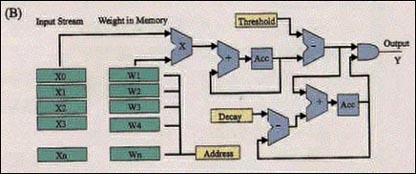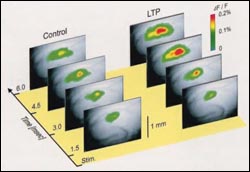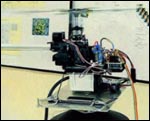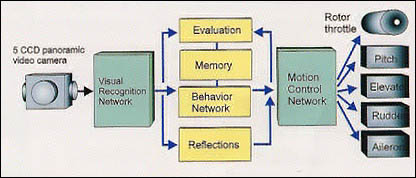 |
Implementing Neurons by Means of Electronic Circuitry |
 |
It is well known that the brain is a gigantic aggregate of nerve cells. The nerve cells form the neural circuitry by extending dendrons and fibers to assume their roles while learning things, while an integrated circuit developed by the human being using semiconductor chips for use as an information processor is regretfully unable to be changed once it has been fabricated in the workshop. However, the progress of semiconductor memory technology and digital signal processing technology has virtually made it possible to implement nerve cells and free circuit configurations. First, let us think of creating a neural learning circuit using such simulated cells.
Fig.1 Nerve Cell Modeling

(A) Simplified Model of Analog Circuit |
-
|
The nerve cells are interconnected through synapses. The dendrons of a single nerve cell have more than 10,000 synapses in order to collect much information, and each nerve cell produces a single output from its axon. When we model these properties, we can express the function as a simplified electrical circuit as shown in Fig. 1 (A). Learning can be incorporated in this model by varying the resistance shown in the figure. However, it is hard to implement with high reproducibility the various properties of the nerve cell (such as impulse generation, refractory period and complex chemical cascade) with such an electrical analog circuit, and it is also not easy to change the connections between nerves.
|

(B) Functional Block Diagram of Digital Circuit |
-
|
Fig. 1 (B) shows the scheme of an electronic circuit which can solve the above problems by means of digital signal processing. Thanks to the high speed of digital processing, such a circuit is capable of responding at a high enough speed even when the addition of originally concurrent synapses are input into a sequential operation.
|
It is also capable of virtually implementing the properties of nerve cells by incorporating them as signal processing circuits.
In addition, it allows the free modification of connections between nerves by applying data transfer technology.
At present, our laboratory has advanced the above ideas further and is developing a memory-based computer with simpler implementation of brain functions using electronic circuitry by considering synapses as the archive storage devices (Fig. 2).
This computer consists of electronic circuitry with the function of executing the computation models of simulated nerve activities as described above at high speeds and of generating links between symbols. The hardware includes a 64 MB semiconductor memory chip and 100,000-gate programmable logic circuitry.

| Fig.2 | Brain Type Computer Prototype Implemented with Digital Signal Processing |
|
-
|
Nevertheless, even if electronic circuitry can implement very realistic nerve cells and if large numbers of such nerve cells can be integrated, it is still impossible to create a brain. This is because the nerve cells are components of the brain but not the principles organizing the brain. To create a brain, it is required to organize the nerve cells as a brain, understand the principles of learning for acquiring information processing methods and link the paths to the cells, and brain circuits.
|
|
 |
 |
Investigations into the Learning of Neural Circuitry |
 |
|
Actual brains learn things based on and one of the most important among these is the functioning of neural circuitry in the limbic system of the hippocampus. We are conducting research into the learning of the brain by establishing an optical measurement technique for investigating the functions of the hippocampus.
|
Fig. 3 show activities in the hippocampal CA1 region captured using an ultrahigh-speed camera developed in our laboratory. The picture on the left is the reference photo and that on the right shows the activities after high-frequency stimulation was applied by modeling the learning process. These photographs show clearly that the high-frequency stimulation has changed the nerve properties and the same stimulation as before enhances the activities and broadens the areas where they are transmitted.
|
-
|

| Fig.3 | Long-Term Potensiation Phenomenon of the Hippocampal CA1 Region Captured on Potential-Sensitive Dyes Using a High-Speed Camera |
|
The purpose of experiments of this kind is to analyze the detailed actions of nerve cells that are modified by various stimulation patterns and medication effects, and to understand the course of progress in learning by the brain.
We believe that it will be possible to link the property changes of nerve cells and of neural circuitry behaviors through learning by reflecting the results obtained in these experiments.
|
 |
 |
Computers that Aim for the Target |
 |
The human being has targets in life, and daily life consists of efforts for achieving these aims. The brain assumes the smaller targets of current situations se-rving the life target (larger target) and commands actions for achieving these. The essence of the brain may lie in the capability of deciding actions by analyzing and understanding the targets and that of mobilizing and externally acquiring the required knowledge for this purpose.

Photo of a Model Helicopter Induced to Fly by Using a Brain Type Computer. |
-
|
For instance, when one has to solve problems in order to reach a goal by avoiding obstacles and making detours as required. In doing this, one needs the capability to select a small target that may seem to be in contradiction to the larger target based on the current situation and of devising optimum methods from one's own knowledge. This target setting mechanism is critical for nerve cells to acquire a function through learning. This is because it consists of learning and circuit organization progress by grasping the target given for the entire brain, setting the partial target to be achieved by a fraction of the brain, grasping it again, setting smaller targets for the neural circuitry and nerve cells, and eventually arriving at the target of connecting synapses.
|

Fig.4 Model Helicopter Induced to Fly by Using a Brain Type Computer System Configuration. |
At present our laboratory is fabricating an autonomous helicopter by setting the target of flying (Fig. 4). In order to fly the helicopter, the computer is required to acquire the method of servo motor-based vector control by rotating the rotor and utilizing video information input from a camera.
|
It should convert this information in the video signal captured with a panoramic camera composed of five CCD sensors by means of a vision processor circuit into a signal containing the vectors of the XYZ-axis components, etc. This signal is introduced to both a memory-based computer which determines behavior and a simulated nerve cell circuit which corresponds to instinctive reflections. Based on the interaction of these two circuits the computer acquires a vector control method for the helicopter to remain stationary in the air through learning.
The vector control circuit converts the activities of the simulated nerves into the operating angles, etc. of the actual servo motor. This helicopter experiment is a model for the achievement of a target set in reality, and will have applications in many fields when completed. Although the helicopter is still incapable of flying, we believe that some day which is not too distant it will be high up in the sky.
|
 |
|
|
|






